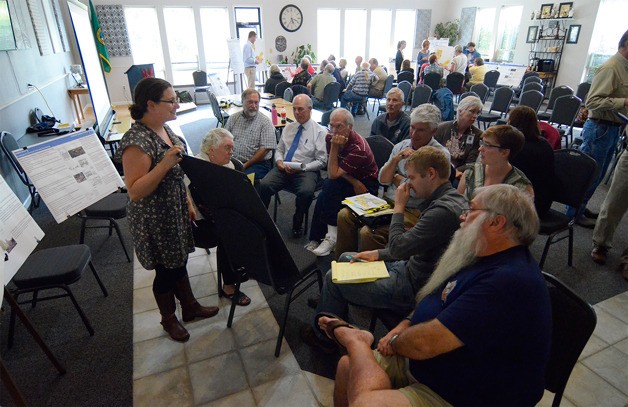Developing rules to guide growth in Freeland was the topic of a public meeting Tuesday, and it did just what it was supposed to — draw a healthy cross section of people with varying views and visions.
Area residents, non-area residents, elected officials, no-growthers, advocates for responsible growth, commercial interests and more were among the many voices present. In all, more than 50 people attended the afternoon meeting held at Whidbey Water Services.
Organizers were pleased.
“It’s a great turnout,” Island County Commissioner Helen Price Johnson said.
The meeting was organized by Island County Planning and Community Development leaders. The department is working to update the comprehensive plan, which includes work on the Freeland Subarea Plan. Adopted in 2010, it lacks development regulations and a capital facilities plan, and the meeting was specifically held to get community feedback on what they should look like.
Planners sought public input on topics ranging from aesthetics, such as building design and lighting, to meatier issues like the location of future development and zoning. Following a brief overview of the history behind the subarea plan, and the process ahead, attendees were asked to fill out a survey and then broke into three discussion groups.
There planners utilized maps and asked focused questions to drive conversations; comments were recorded on poster-size sheets. While feedback varied by group, anti-city residents made a strong showing.
“I’m adamantly opposed to incorporation,” said Rod Mourant, of Freeland.
He passed out bumper-stickers that read “Freeland WA, Proudly Unincorporated.”
Brad Johnson, a senior planner for Island County, urged people to focus on the topic at hand, saying incorporation was a separate conversation. The county is required by law to hammer out development regulations, while becoming a city is elective and would only result if pursued by the community.
Johnson did say, however, that completing the subarea plan would make any incorporation effort easier as it would address some of the requirements needed to become a city.
Similarly, any changes to Freeland’s existing non-municipal urban growth area boundaries is a discussion that should be had later. Several people disagreed with the position, saying it was hard to opine on development rules without knowing the exact area of discussion.
“Seems like you’re putting the horse behind the cart here,” said Ron Wallick, also a Freeland resident.
Some lobbied for tighter rules when it comes to drainage, with some referring to problems at Sunny View Village, an affordable housing development off Highway 525.
Several people who don’t call Freeland home were also in attendance and weighed in. Reece Rose, a Clinton resident, said the county should adopt regulations that encourage development on the south side of Highway 525, while Jason Joiner, a Coupeville resident in real estate, advocated for light industrial zoning.
“These zones produce jobs, not just housing,” he said.
Topics such as parking, building height limits, densities, greenspace and signage were also discussed by the focus groups.
According to Planning Chief Dave Wechner, planners will go over the input this month and use it to draft regulations, which will be presented at a public meeting in September. A meeting is also planned in August that will focus specifically on the urban growth area boundaries.



